Namche Bazaar (11,385ft) to Dole (13,355ft) to Gokyo (15,660ft) to Gokyo Ri (17,586ft) to Dole (13,355ft) to Namche Bazaar (11,385ft)
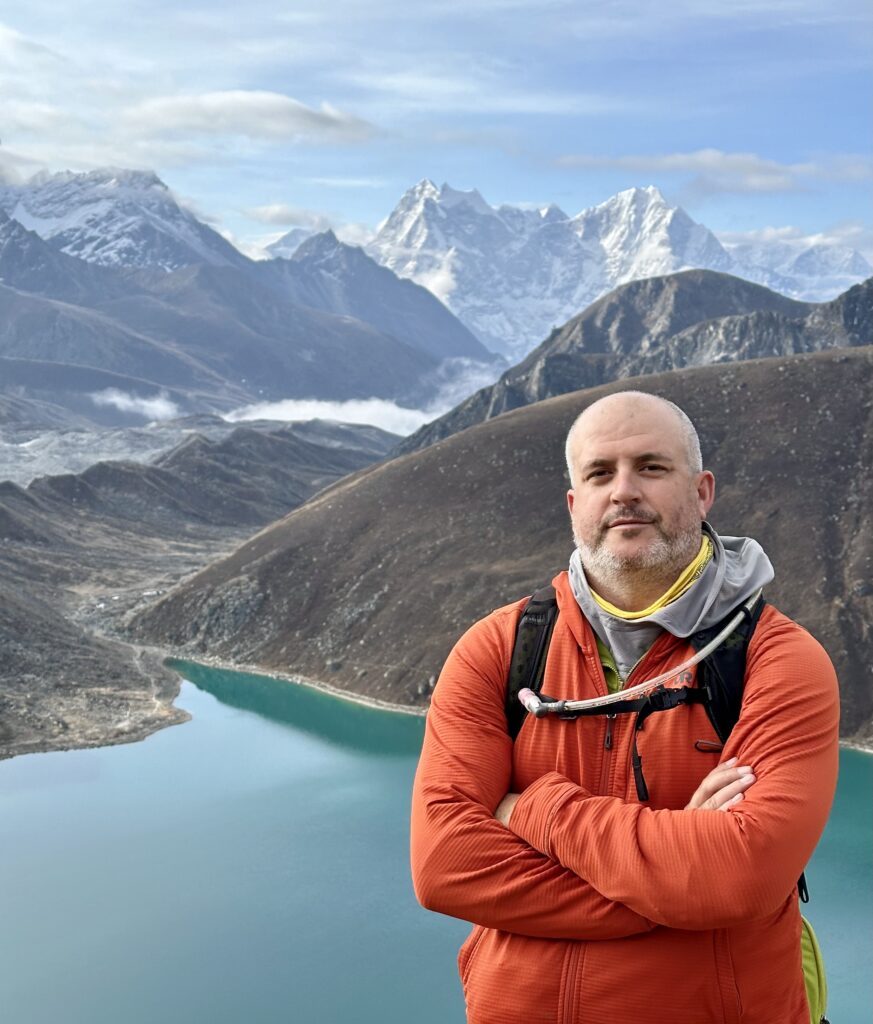
#Miles4Missions Itinerary
Day1 (May 12th)–Bixby to Kansas City to Newark
Day2 (May 13th)–Newark to Dubai to Kathmandu
Day3 (May 14th)–Kathmandu
Day4 (May 15th)—Kathmandu to Lukla to Phakding
Day5 (May 16th)–Phakding to Namche Bazaar
Day6 (May 17th)–Namche Bazaar
Day7 (May 18th)–Namche Bazaar to Dole
Day8 (May 19th)–Dole to Gokyo
Day9 (May 20th)–Gokyo
Day10 (May 21st)–Gokyo to Gokyo Ri to Dole
Day11 (May 22nd)—Dole to Namche Bazaar
Day12 (May 23rd)—Namche Bazaar
Day13 (May 24th)—Namche Bazaar to Tengboche
Day14 (May 25th)—Tengboche to Dingboche
Day15 (May 26th)—Dingboche to Lobuche
Day16 (May 27th)—Lobuche to Everest Base Camp
Day17 (May 28th)—Everest Base Camp
Day18 (May 29th)—***RACE DAY***Everest Base Camp to Namche Bazaar
Day19 (May 30th)—Namche Bazaar
Day20 (May 31st)—Namche Bazaar to Lukla
Day21 (June 1st)—Lukla to Kathmandu
Day22 (June 2nd)—Kathmandu to Dubai to Newark
Day23 (June 3rd)—Newark to Kansas City to Bixby
“Count it all joy, my brothers, when you meet trials of various kinds, for you know that the testing of your faith produces steadfastness. And let steadfastness have its full effect that you may be perfect and complete, lacking nothing”
-James 1:2-4
My favorite week of every semester in my college years was finals week. I know that makes me an oddball, but I like tests. There, I said it. I loved the opportunity to see where I really stand. I genuinely wanted to find out if I truly understand the things I have spent the last 15 weeks studying; or do I need to revisit the material before I proceed.
I have spent a good portion of my life in the classroom—both giving and receiving lectures; I abhor grade inflation with the passion of 1,000 suns. If I am a D+ student, I want to find that out in the classroom setting, not when the stakes are higher in ministry or the marketplace. I understand the complexities and pressures on teachers/professors that lead to them doling out A’s to C- students. Still I hate it. It does the student a great disservice that they might not realize for many years to come. I cannot tell you how many people I have counseled in their early adult life that either couldn’t get or couldn’t keep the jobs for which they were supposed to be qualified after enormous financial investment in their education. It is a kindness to fail a student when they do not demonstrate the competencies necessary to proceed.
As a child, my father incubated and raised chickens. I remember asking him while watching a few chicks strain and struggle to get out of their shells, “why can’t we help them out of their shells?” Almost before I finished asking, he replied, “if we help them they will die.” Only years later did I really understand what was happening as the chicks fought through the shell that enclosed them. I thought they were trying to get out of the shell when in reality they were using the resistance of the shell to build the muscles necessary to sustain life outside of the shell. If their struggle with the shell strengthened them enough, they would escape the shell with no trouble. If they did not, they had no chance of living even if they managed to get out of the shell.
The mountain can be a cruel environment and it affords little place for mercy. One cannot be helped along up the mountain. Mountaineers must grind out each meter of elevation under their own power if they are to have any hope of sustaining their progress. This process of incrementally pushing one’s body to higher and higher elevations to force it to adapt to increasingly oxygen depleted environments is called acclimatization. Acclimatization is a grueling undertaking, but it is absolutely essential. If an unacclimatized person were to be flown by helicopter from sea level to the summit of Kilimanjaro (19,341ft) they would be unconscious in 2 minutes and dead in 1 hour. However, if the same person were to spend a long week climbing slowly higher each day; amazingly, they can undergo such a transformation in their bodies that they can survive on the summit.
The length and difficulty of the acclimatization depends upon the final goal elevation. If someone is trying to summit a 14,000ft mountain such as the ones we have in Colorado; they can acclimatize in only a couple of days. If their goal is the summit of Mount Everest (29,030ft), the acclimatization schedule takes nearly two full months. Preparing to run the World’s Highest Marathon that starts at 17,586ft, requires somewhere in between those two extremes.
We built my acclimatization schedule for the Everest Marathon to include two primary acclimatization cycles—the first would be a 5 day trip up the Gokyo valley to a final elevation of 17,586ft at the summit of a place called Gokyo Ri; the second would be the 4 day hike up to Everest Base Camp itself (coincidentally the same exact elevation as Gokyo Ri) en route to the start line of the marathon. These two cycles would be split up with a two day rest break in Namche Bazaar to allow for a bit of recovery from the first cycle up to Gokyo Ri.
***Since I had little internet connectivity in the Gokyo Valley, and also because the cycle was very physically and mentally taxing; I was unable to post daily as I had planned. Instead, I wrote each day’s summary as I went and have compiled them all into one post here.***
Day 7–Namche to Dole
For as great as the weather was yesterday at the Everest View Hotel, it was equally terrible today. We had low lying fog and next to zero visibility for most of the hike. Every day with poor weather here is a real bummer, because there is just so much to see everywhere you look and you feel like you are being robbed by the fog and clouds.
This was a pretty tough day on the trail. The trail to Gokyo splits off from the traditional trail to Everest Base Camp after a few easy miles leaving Namche and that is where the real fun began. I don’t know what the percentage of trekkers making the right turn to EBC was to those making the left turn to Gokyo, but I would guess it was something close to 90% headed to Everest, so from this point on it kind of felt like we had the trail to ourselves.
Right after the trail split we had a pretty steep climb up over 13,000ft to the village of Mongla. The climb up to Mongla was tough, but manageable. We stopped there for some Sherpa stew, which is quickly becoming another of my favorite menu items on the trek. The skies cleared a little directly over us, but not really revealing any of the mountains which are otherwise very visible from Mongla. That said, we did get a very cool pic of a rainbow circling the sun. I think this might have been the only pic I took on this day, given the gloomy weather and difficult trekking.
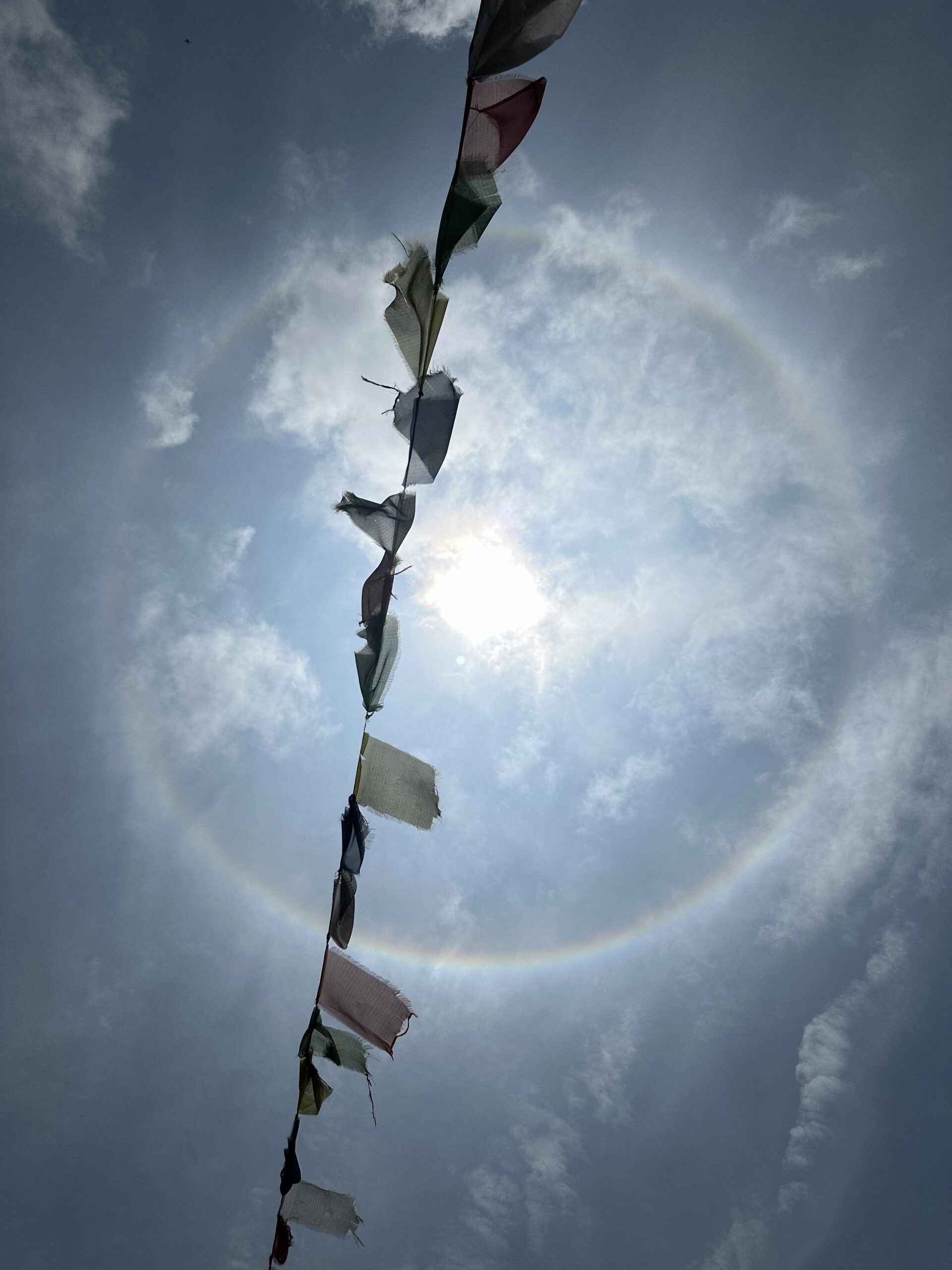
From Mongla the trail descends sharply more than 1,500ft to the river at the bottom of the valley in a place called Phortse Tenga. It was pretty frustrating to give back all of the elevation that we had earned from Namche to Mongla, especially knowing we were about to earn it all back to get to Dole where we would stop for the night. The trail up to Dole was also pretty tough and by the time we got there I was very spent.
There is not much to Dole, just a few tea houses and I can’t tell you if it offers good views of not. I didn’t get to see any. All told, we logged right at 8 miles and 3,600ft of elevation gain topping out at 13,355ft in Dole. I was feeling both the fatigue and the elevation, so I grabbed an early dinner of veg fried rice, to which I added a tuna packet for some protein, and headed straight to bed.
Day 8–Dole to Gokyo
We woke up to another day of not awesome weather, took our time with breakfast, and then hit the trail. The traditional itinerary calls for a very short day of trekking from Dole to Machermo (14,603ft), which most people can reach in around 2 hours. The reason for the short day is to provide more time for acclimatization. Some teams will even spend two nights in Machermo to better prepare themselves for the extreme elevation that awaits them as they ascend the Gokyo valley.
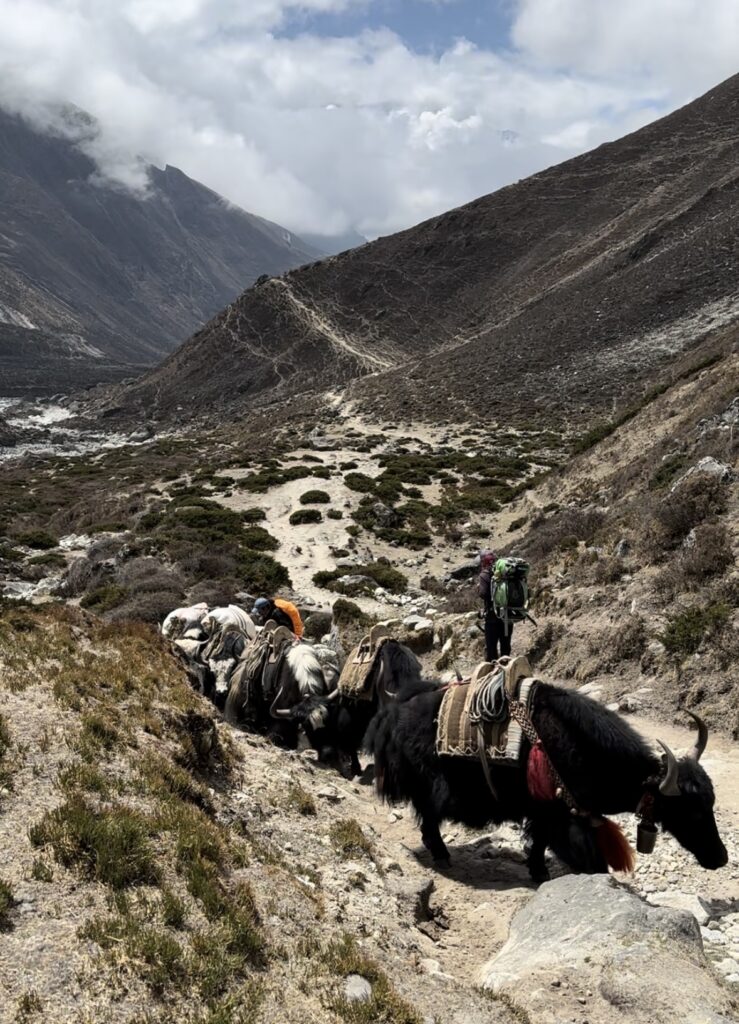
I was feeling pretty good and made it to Machermo in a casual 1:45. We planned a long stop for a very early lunch at which time we would make a decision about parking at Machermo for the night or pushing on to Gokyo (15,658ft). Gokyo is another 4.5 miles and the elevation gain is significant. Pushing up from 13,350ft in Dole to 15,658ft in Gokyo in a single day is a very big jump and is definitely not recommended for people without experience at high elevation.
However, the weather had been rough and the view from Gokyo Ri is one of the best in the whole world. If I could push up to Gokyo today, I would be a full day ahead of schedule and give myself a far greater chance at good weather on the summit of Gokyo Ri. We decided to go for it. We set out for Gokyo a little before noon in cloudy weather. The trail out of Machermo begins with short but steep climb and then levels off a bit into an otherworldly terrain. It is probably best described as a moonscape. The valley opens wide and there are no more shrubs or greenery; just sheer cliffs on both sides and massive charcoal and grey colored boulders, some the size of school busses, littering the bottom of the valley where a rushing river falls over and over again on itself down towards Machermo and Dole.
This section of terrain is really like an elevation band around the Himalayas that marks the separation between the lush green foothills filled with rhododendrons and the white-capped peaks jutting high into the jet stream. We encounter something similar once you pass the village of Deurali on the trek to Annapurna Sanctuary, and Annapurna Base Camp itself resides in the moonscape band.
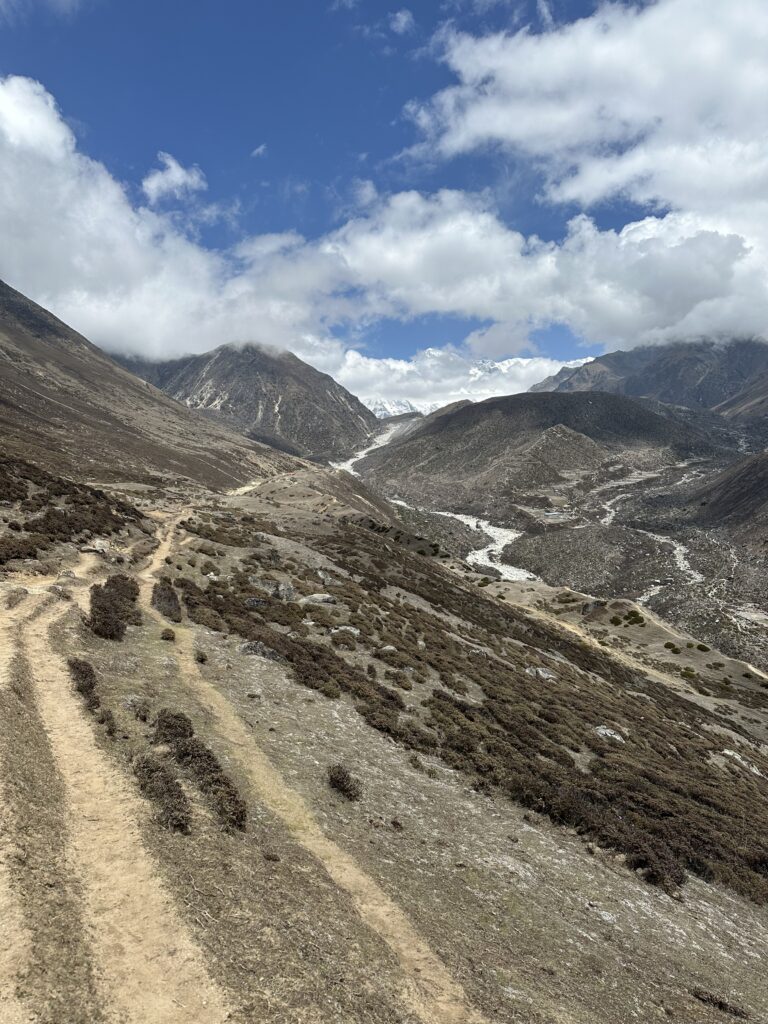
The exit at the top of the valley is visible for nearly two miles as you ascend the valley. It is a gnarly climb aided in a place or two by a concrete staircase. Other than the presence of a handrail and the perfect shape of the steps, the grey concrete blends in perfectly with the surroundings. Once you clear the steps, you are immediately confronted with the first of the six Gokyo lakes. The village of Gokyo is on the shore of the 3rd lake and each offers a perfect blue against an otherwise black and white world.
As I am passing the first lake, I am met by a change in the weather. All around me it is lightly snowing and sleeting. It is not so much falling as it is just kind of there. We are walking through the clouds after all. Another couple of brief climbs alongside the next two lakes and finally we arrive at Gokyo.
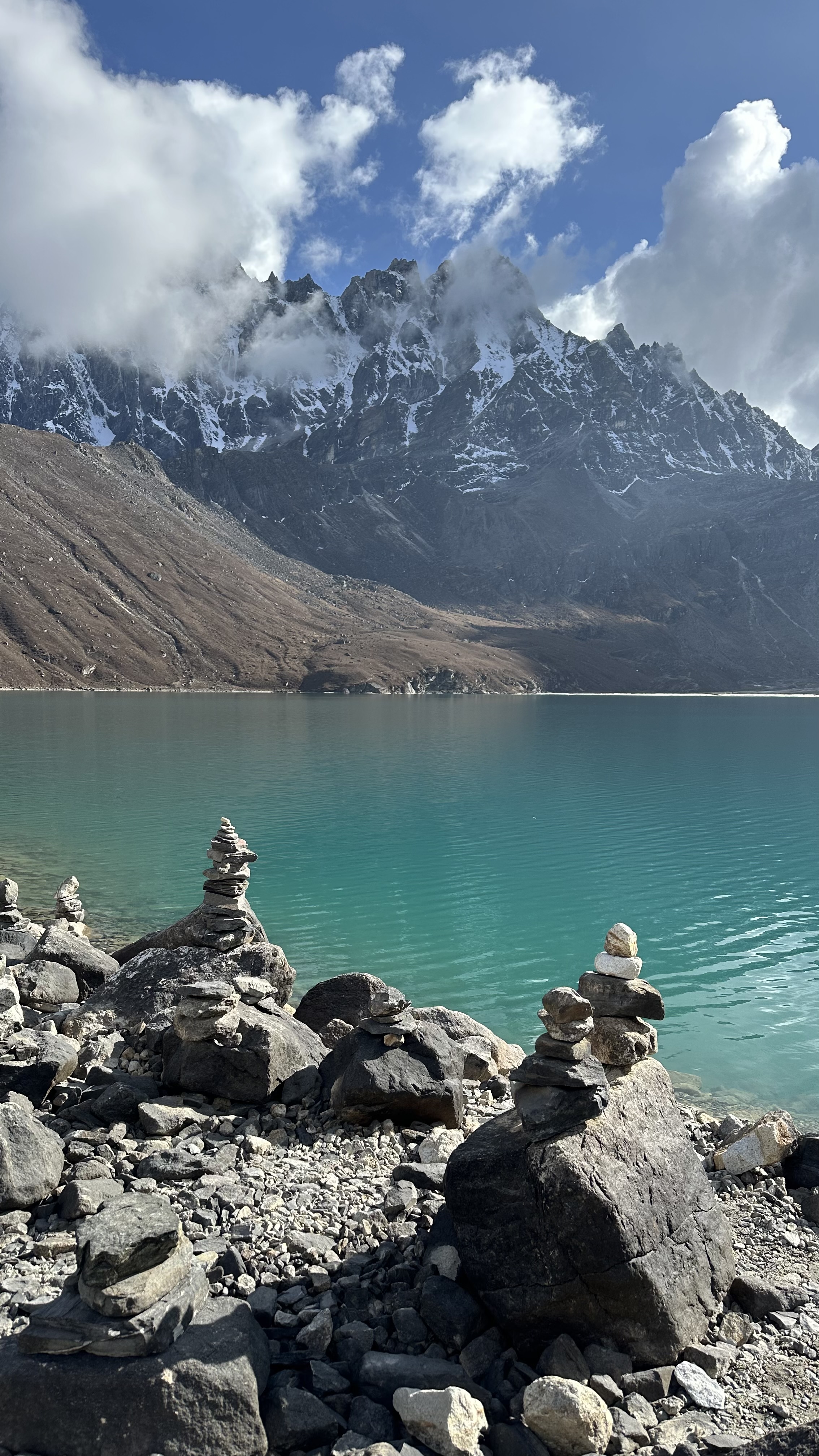
We get checked into our tea house on the shore of the lake and I notice the beginnings of a small headache. I quickly take a couple of Advil to get ahead of it, and start alternating drinks of water and hot lemon with honey. The headache is not unexpected given my choice to push on to Gokyo. As my African friends tell us as we make our way up Kilimanjaro: “nausea, vomiting, headache…all normal on the mountain.” After my second bowl of Sherpa stew for the day, I am already feeling better. To be honest, even with the headache, this is probably the best I have ever felt in my many times to break 15,000ft. I decide to get a little rest before a proper dinner of momo, a kind of Nepali dumpling that they are both very proud of and also very adamant that you don’t ever pluralize with an “s”…the plural of momo is momo.
All in all a tough but good day. Will my gamble to push on to Gokyo pay off? I suppose we will find out soon enough.
Day 9–Rest/Gokyo Ri Attempt
I didn’t sleep particularly well on night one at Gokyo, which is not all that unexpected given the elevation, and I find myself awake at 4:00AM. I take a quick look out my window to see the magnificent Cho Oyu, the world’s 6th tallest mountain on the border of Nepal and Tibet, looming at the end of the valley. That I can see the peak is evidence of clear skies. I roll over for another hour or so of sleep excited that it seems the weather may be smiling on us. When I get out of bed a little before 6:00AM, I check the window again and I cannot even see the adjacent tea house. The fog has rolled in and now it makes no sense to attempt the more than 2,000ft climb up to Gokyo Ri.
It is a very chilly morning, and I enjoy a nice breakfast of noodle soup in the dining area and sit by the stove while sipping some tea. The dining area of nearly all of the tea houses has what looks to be a wood stove in the middle to heat the room. One problem though—we are well above tree line and there is no firewood. The Nepalis have devised an interesting solution to this dilemma. They fuel their stoves with dried out yak dung dipped in kerosene. I don’t see that catching on in the States, but it works fine here.
I spend most of the morning in the only heated room in the tea house enjoying hot lemon’s and waiting to see if we would get a break in the weather to make a summit attempt on Gokyo Ri. In early afternoon it began to snow lightly so I went to my room to try to take a nap. For the second time of the day, I woke to find the skies clear so we decided to ready ourselves for an attempt on the Ri. If we were lucky, we might catch sunset on the high peaks.
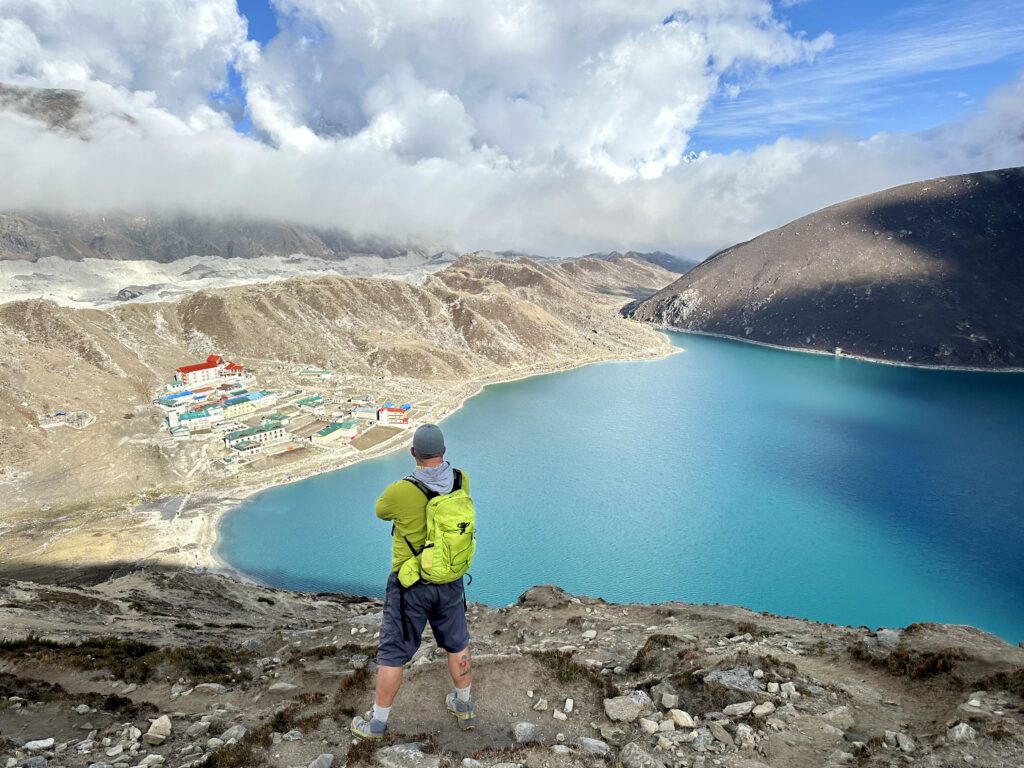
It is only about 1.5 miles to the top of Gokyo Ri, but it is very steep trail with virtually no reprieve from the ascent. From the first few steps, I was struggling. Each step was a mental war, and about the time we reached the half way point around 16,500ft, the clouds rolled in again and we decided to abort our summit attempt and try again in the morning. Despite my disappointment, I think the clouds were mercy for me. I am not sure I had it in me to finish the climb. We made our way back down and agreed we would set our alarms for 3:00AM in order to try to reach the summit around sunrise, and maybe the skies would be clear around that time as they had been that morning.
Day 10–Gokyo Ri to Dole
I have never been able to sleep until an early morning alarm. For some reason my anxiety wakes me well before, so I was up around 2:00AM. I kept peaking out the window hoping for clear skies and though there were a few clouds, it seemed that most of the sky was clear. I waited till just before 3:00AM and rolled out of bed. The main goal of the climb was my acclimatization, so we were heading up to the summit with or without clear skies, but obviously we were hoping for the latter.
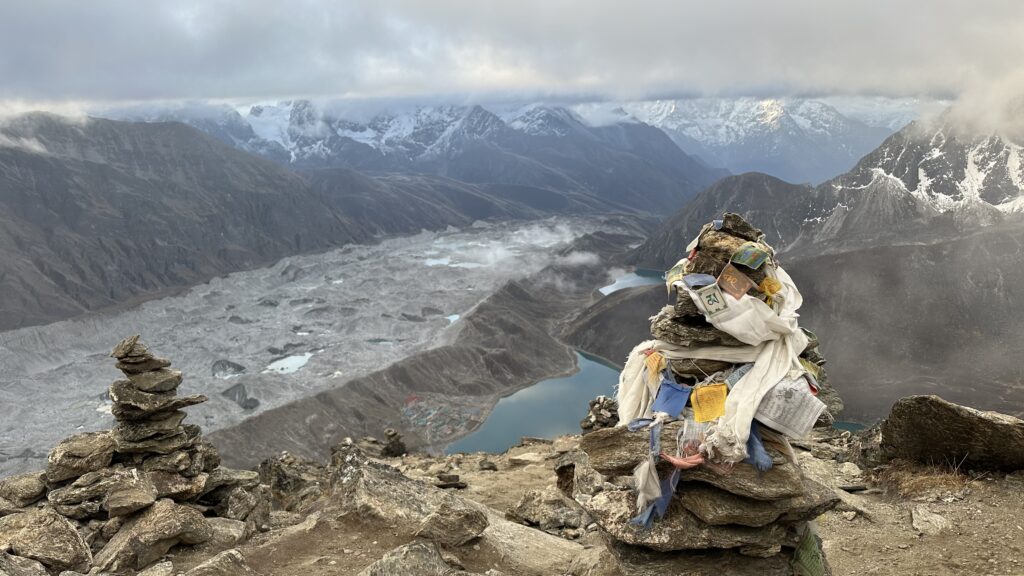
I was definitely refreshed a bit from the night of sleep, but the climb was still a grind. We were definitely the only people on the mountain in the dark hours. We didn’t see a single other person until we were almost down off of the mountain. As we were climbing I found myself looking down at my watch doing elevation checks far too frequently, which is not an awesome sign for me. Despite my struggles, we eventually made it to the summit of Gokyo Ri under a low cloud ceiling. This meant that we had incredible views of everything below us, including the lakes and Nepal’s largest glacier, but no visibility of the high peaks. We decided to wait it out a bit and see if the weather improved. We waited on the summit for nearly an hour. The clouds were moving around us, but we never got the window we hoped for and we knew we had a long day on trail ahead of us and we were getting pretty cold, so we made the decision to head back down to Gokyo.
When we got around 3/4 of the way down from the Ri we saw the first group of climbers heading up. Unfortunately for us, but lucky for them, the skies began to open. We talked very briefly about re-climbing the peak to take in the views, but I just couldn’t make myself climb that bad boy a third time in less than 12 hours. We accepted that we had been a bit unlucky and resigned ourselves to beginning the journey back to Namche.
Namche is a full 16 miles away from Gokyo and though it is downhill; it is not all downhill. My legs were dead from the three hard days of climbing in this cycle, so I was fine to call it a day when we made it back to Dole. We left ourselves 8 more miles back to Namche, where two full days of much needed rest were waiting on us.
Day 11–Dole to Namche Bazaar
I tried to sleep in today, but was unsuccessful, so I made my way to the dining area to check in with home. I had been without internet since leaving Dole in the morning of Day 9, so it was great to catch up on the outside world. After a lazy breakfast, we set out for Namche. The hike between Dole and Namche is a pretty easy one with the exception of the climb from Phortse Tenga up to Mong La. I was kind of dreading the climb to be honest, but I took it slowly and handled it fine. It is honestly wild to feel at home at 13,000ft, but that is kind of the whole point of this acclimatization cycle.
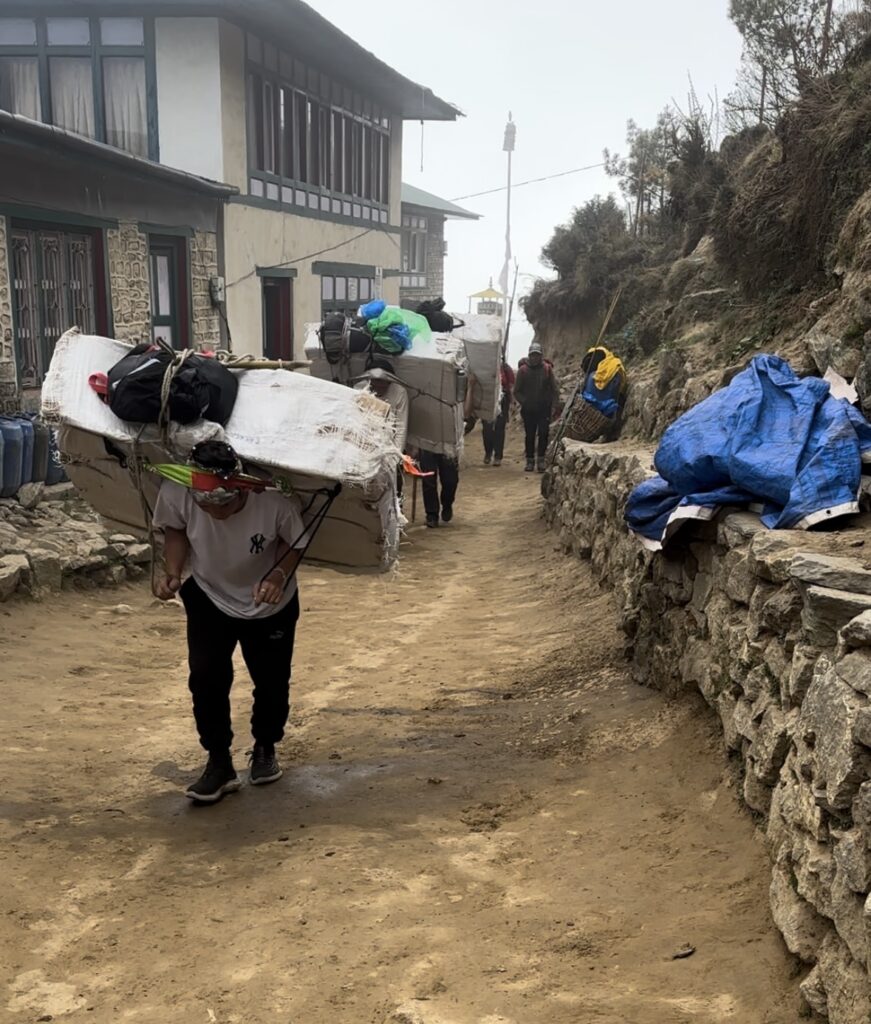
We stopped for a drink in Mong La and then took it easy for the next few miles back into Namche. Namche is a place of relative comfort here and it felt so nice to get checked back in to the familiar Nirvana Home. I put all my electronics on the charger, did a bit of laundry, and took a much needed shower.
I had planned to explore Namche a bit this afternoon, but it started to rain, so I decided to stay in and watch a couple of short documentaries about ultra-runners to bank some motivation for next week. I have a few things to do here in Namche tomorrow—planning to get a haircut and explore a bit, but the main thing on the agenda is just to rest. I will begin the journey up to Everest Base Camp the day after tomorrow, and race day is one week from today.
I hope you are enjoying following along with our #miles4missions journey. If you are, would you do 3 things for me:
First, would you tell your friends about our project. We have an awesome video summarizing what #miles4missions is all about on the #miles4missions page. Check it out if you haven’t yet seen it and share it and all of our #miles4missions posts in your circles.
Second, if you haven’t yet signed up for our newsletter, we would love it if you took 30 seconds and did that now. We won’t spam you. We just want to keep you in the loop with all things Project Doxa and Discipletrek.
Finally, if you haven’t yet personally invested in our #miles4missions project, would you consider making setting up a one-time or monthly donation now via our giving portal at projectdoxa.kindful.com. We have a lot of really awesome people doing really awesome work that are counting on us make a significant investment in their ministries via #miles4missions.
Leave a Reply